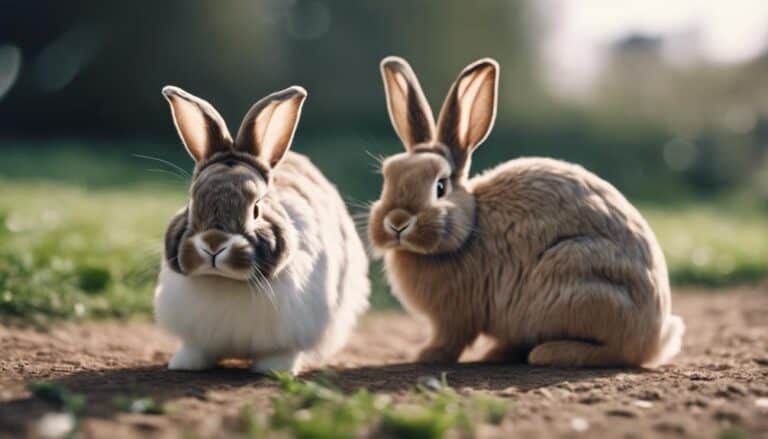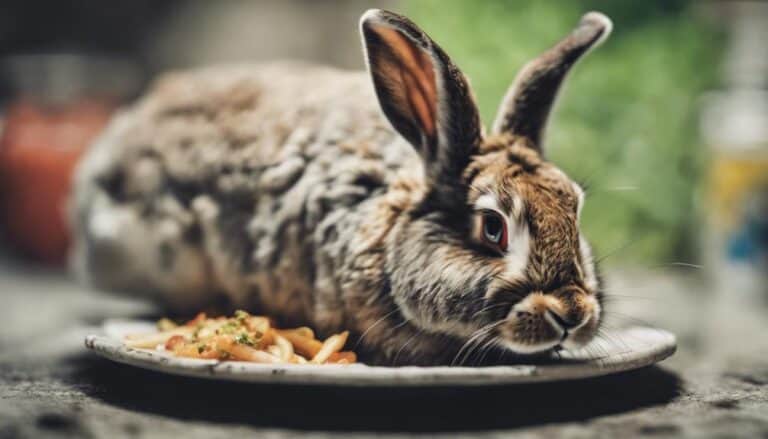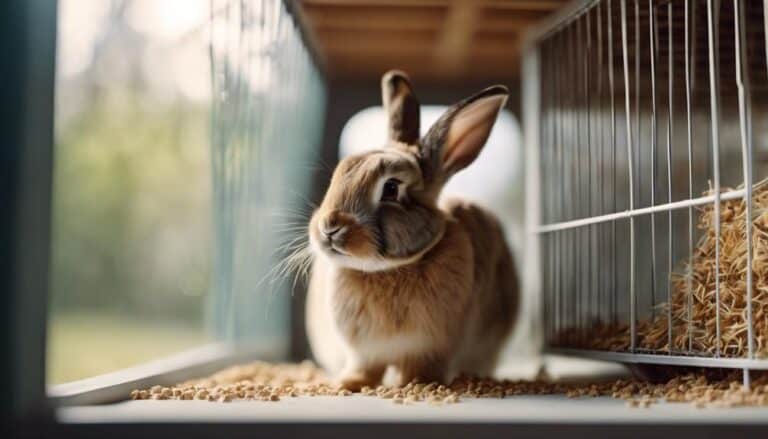Bunnies hop by using their strong hind legs and special feet to jump up to 4 feet high and cover distances of up to 10 feet in one hop. Their powerful leg muscles and lightweight skeleton help them to be agile and leap impressively, even from a standstill.
Bunnies are really good at coordinating their muscles efficiently to hop, which helps them survive and show off their amazing athleticism. These physical adaptations allow them to escape from predators, move around tough terrain, and communicate messages through different hopping patterns.
It's pretty fascinating to learn more about how bunnies hop!
Contents
- 1 Key Takeaways
- 2 Bunny Hopping Mechanism
- 3 Anatomy of Rabbit Hopping
- 4 Rabbit's Powerful Hind Leg Muscles
- 5 Skeleton Adaptations for Hopping
- 6 Energy Efficiency in Bunny Hops
- 7 Nervous System Coordination in Hopping
- 8 Metabolic Demands of Bunny Hopping
- 9 Speed and Agility in Rabbit Jumps
- 10 Communication Through Bunny Hops
- 11 Social Dynamics of Bunny Hopping
- 12 Frequently Asked Questions
- 13 Conclusion
Key Takeaways
Bunnies hop by using their strong hind leg muscles to give them power and agility. Their lightweight skeleton has specialized bones that help them hop efficiently. This means they can move quickly and easily without using too much energy.
Their hind legs have muscles that contract in an energy-efficient way, which helps them conserve energy while hopping. Their nervous system is also really good at coordinating their muscle movements, so everything works together smoothly when they hop.
Thanks to their strong back legs, rabbits can reach speeds of up to 45 mph. This speed and agility come from their ability to use their hind legs effectively when hopping.
Bunny Hopping Mechanism
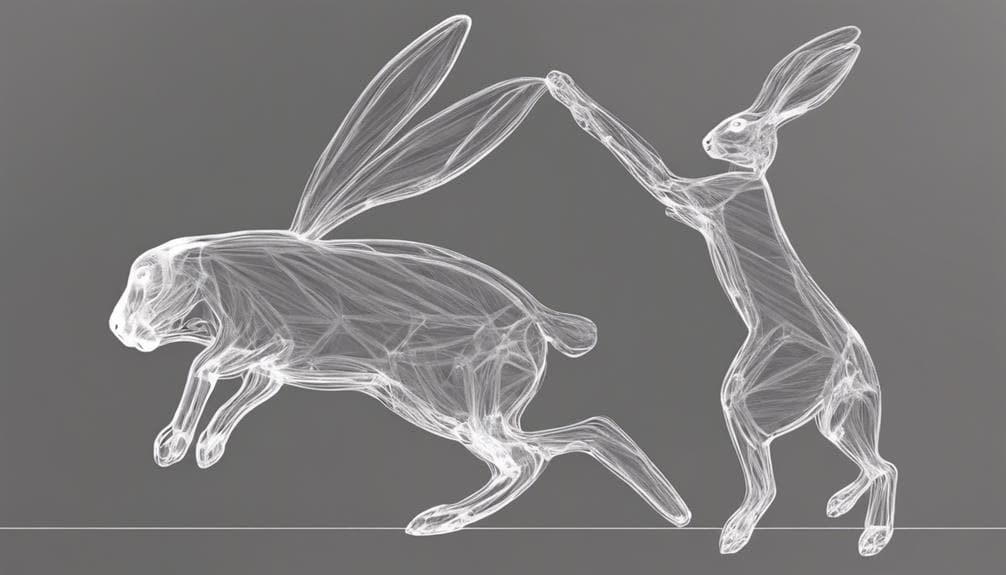
Bunnies hop around using their strong hind legs and special feet. They can jump up to 4 feet high and cover distances of up to 10 feet in one go. This hopping skill helps them escape from predators and move quickly across different terrains.
Bunny hopping is energy-efficient, which means they don't waste a lot of energy while hopping around. By using their hind legs to jump, bunnies can go fast and be agile without getting tired quickly. This efficient way of moving not only helps them run away from danger but also lets them travel long distances to find food, a safe place to stay, and other bunnies.
When you watch bunnies in the wild, you can see how graceful and effective their hopping is. Each jump shows how their strong hind legs, unique feet, and survival instincts all work together perfectly.
Anatomy of Rabbit Hopping
Rabbit hopping is all about power and agility, thanks to their special muscles and bones. When a rabbit gets ready to jump, its strong hind legs are key to giving it the push it needs to move forward. Let's take a closer look at how their anatomy helps them hop like pros:
Rabbits have some seriously powerful hind leg muscles, even stronger than those of a cheetah. These muscles help them launch themselves forward with a lot of force, allowing them to cover big distances in just one jump.
Their skeleton is super lightweight, which helps with their agility by reducing the weight they need to move. This light structure lets rabbits leap up to a meter from a standstill, showing off how nimble and quick they are.
With their strong muscles and light bones, rabbits can jump around 2 feet high on average. Wild rabbits, known for their top-notch athleticism, can jump even higher and farther, showing off just how agile and powerful they really are.
Rabbit's Powerful Hind Leg Muscles
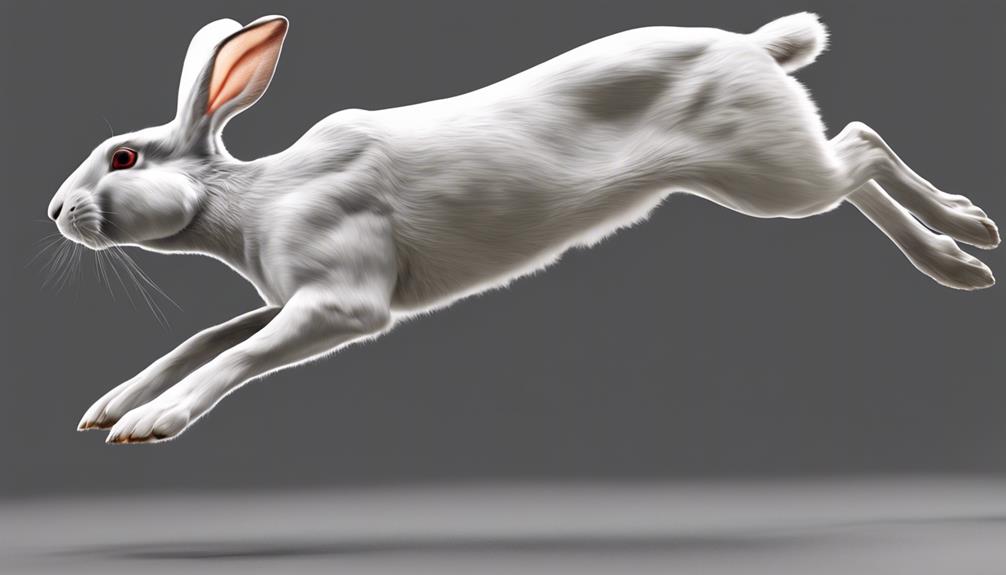
Rabbits have incredibly strong hind leg muscles, which are 29% stronger than a cheetah's. This strength gives them the ability to leap impressive distances in just one jump. These muscles are crucial for their jumping prowess, allowing them to launch themselves up to a meter from a standstill.
Thanks to their powerful hind legs, rabbits can cover up to 10 feet in a single bound, showing off their agility and strength.
In the wild, rabbits with their well-developed hind leg muscles can jump even higher and farther than their pet counterparts. This extra muscle power helps them navigate tough terrains and escape from predators with ease. The highest rabbit jump ever recorded in the Guinness World Records is 3.2 feet, highlighting the remarkable power and flexibility of their hind legs.
Skeleton Adaptations for Hopping
Have you ever noticed how a bunny's bones, leg muscles, and joints come together to help it hop?
The bunny's lightweight skeleton, long hind legs, and strong digits all work together to make hopping easier for them.
These skeletal adaptations are key for bunnies to hop efficiently and keep going for a long time.
Bunny Bone Structure
Bunny skeletons have elongated hind legs with specialized bones to generate powerful leaps. These bones are designed to be lightweight, helping bunnies conserve energy while hopping around.
The long bones in a bunny's hind legs act as lever arms, amplifying the force produced by their muscles for efficient propulsion. This skeletal structure is perfectly adapted for their hopping lifestyle, allowing them to move quickly and agilely in their environment.
Muscles for Hopping
Rabbits have strong muscles in their hind legs that help them hop really well. These muscles are actually 29% stronger than a cheetah's, which is pretty impressive. With these powerful muscles, rabbits can hop precisely and with a lot of force. This is important for their hopping behavior, allowing them to jump up to a meter from a standstill.
Their lightweight skeleton also helps them be agile, making it easier for them to jump really far. In fact, they can cover up to 10 feet in just one hop! Some wild rabbits can even jump almost 15 feet in a single jump, showing off just how strong and agile they are. It's pretty amazing to see how their muscles and skeleton work together to help them hop so well.
Joint Flexibility Key
The reason rabbits can hop so efficiently is because of how flexible their joints are. This flexibility allows them to move in a wide range of motion, which is important for getting a powerful push with each hop.
Rabbits can zip around so quickly and make precise landings thanks to their special joints. These joints are built for quick movements and accurate landings, giving rabbits the agility they need to navigate their surroundings with ease.
Their skeletal structure plays a big role in supporting their agility. By absorbing the impact of their landings, their joints reduce the strain on their bodies. This not only helps them move faster but also keeps them balanced while they hop around.
In a nutshell, rabbits' ability to hop comes down to their flexible joints. These joints work hand in hand with their skeletal structure to help them move swiftly and gracefully, showcasing how their bodies are finely tuned for agile movement.
Energy Efficiency in Bunny Hops
Bunny hops are super energy efficient because of how their muscles and tendons work together. These little guys can cover a lot of ground without using up too much energy.
Their legs and bones are built in a way that helps them move quickly while still saving energy for all the hopping they do.
The way their hind legs and feet are designed helps them hop with power and agility, making it easier for them to move around and escape from predators.
Efficient Muscle Contractions
Bunnies have super efficient muscle contractions in their hind legs that help them hop around with minimal effort. Their specialized muscle fibers are key to their energy-saving way of moving. Let's break it down:
- Strong Back Legs: The muscles in a bunny's back legs are super strong, helping them push off the ground when they hop.
- Saving Energy: Because of these efficient muscle contractions, bunnies can hop long distances without using up too much energy. It's like they've a built-in energy saver!
- Muscle Teamwork: The muscles in a bunny's legs work together in a coordinated way when they hop. This teamwork helps them move smoothly and efficiently, saving even more energy.
With these cool adaptations, bunnies can hop around using their muscle power wisely, making them agile and sustainable little hoppers.
Elastic Tendons Propel
Rabbits have a cool trick up their sleeves when it comes to hopping around efficiently. They've got these stretchy tendons in their hind legs that work like springs, helping them move with minimal effort.
So, when bunnies hop, these elastic tendons stretch out and store up energy when they land. Then, when it's time to push off again, these tendons quickly release all that stored up energy, making hopping a breeze for them. This smart design means they don't have to use as much muscle power to move around.
Thanks to these special tendons, bunnies can zip around quickly and gracefully, which is super important for staying safe in the wild. By making the most of their elastic tendons, rabbits can hop efficiently and save up energy for important stuff like finding food and avoiding predators.
Minimal Energy Expenditure
When you watch how bunnies do their hops, you can see how they manage to move with very little energy. It's pretty amazing how efficient they're in the way they move around.
Bunnies have special leg muscles that are really good at saving and using energy when they hop. This helps them not waste any energy when they're on the move. Their hopping technique is also super optimized to make sure they don't use up too much energy but still get a good push forward.
One cool thing about bunnies hopping is that it helps them escape from predators. They can quickly change direction and zoom off at speeds up to 45 miles per hour. This ability to hop efficiently really comes in handy when they need to get away from danger.
Nervous System Coordination in Hopping
Bunnies are amazing hoppers because their nervous system helps them coordinate their muscle movements. When a bunny hops, its brain sends signals through the nervous system to its leg muscles. These muscles work together in a synchronized way to give the bunny the power it needs to hop. If a bunny wants to change its hopping speed or direction, its nervous system gives it feedback to make quick adjustments.
The connection between the brain and spinal cord is super important for bunnies to keep their balance while hopping. Thanks to efficient neural pathways, bunnies can do all sorts of fancy hopping moves with ease. By making sure the nervous system and muscles communicate well, bunnies can hop gracefully and swiftly, showing off their unique hopping abilities.
Metabolic Demands of Bunny Hopping
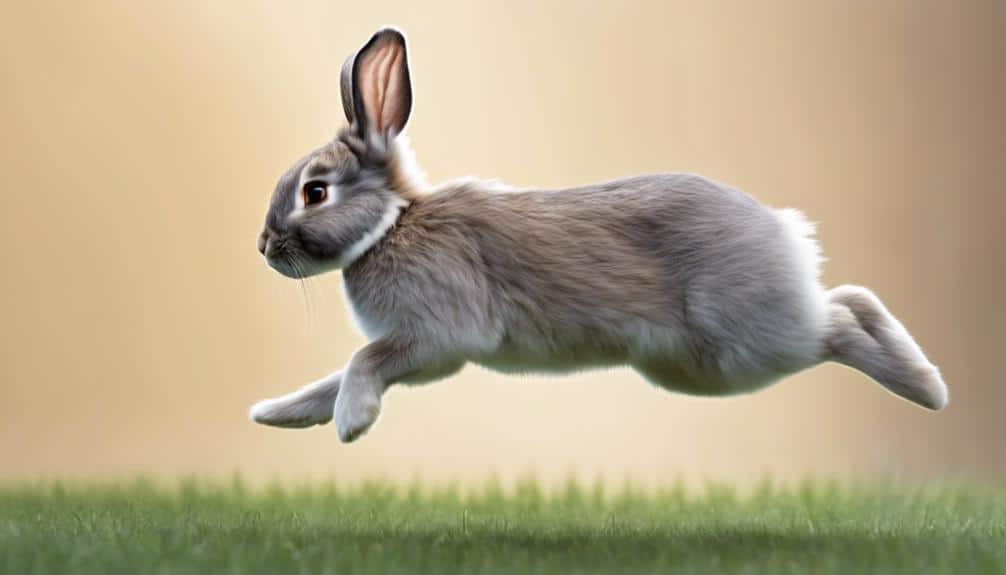
When a bunny hops, its muscles work really hard and need a lot of energy. The quick movements make it important for the bunny to use oxygen efficiently to power its muscles.
To keep up with this intense physical activity, bunnies eat a lot of energy-rich foods to meet their body's needs.
Energy for Hopping
When bunnies hop around, they burn a lot of energy. To keep up with their active lifestyle, bunnies need to eat foods that give them plenty of energy. Here are a few important things to remember:
First, bunnies should eat a diet that's packed with calories. This helps them have enough fuel to keep on hopping and stay energetic.
Second, bunnies rely on carbohydrates for energy. Carbs are like their main source of fuel that keeps them going during all that hopping.
Lastly, it's important for bunnies to have a well-rounded diet. This means they need proteins, fats, vitamins, and minerals to support their hopping habits and keep them healthy overall.
Muscles Used
When bunnies hop, they rely on their hind leg muscles to propel themselves forward. These muscles are crucial for the jumping movement and coordination required for successful hopping. To keep up with the energy demands of hopping, bunnies need to eat foods rich in energy.
The muscles used during hopping not only help bunnies move but also contribute to their overall muscle tone, bone strength, and cardiovascular health.
Oxygen Consumption
Bunny hopping requires a lot of energy, so bunnies need to breathe in a lot of oxygen. When bunnies hop around, their muscles need a bunch of oxygen to keep going. This helps them get the energy they need to keep hopping. It's pretty cool to see how bunnies use oxygen to power their muscles during this fun activity.
The more intense and longer the hopping, the more oxygen bunnies need. This shows how good bunnies are at using oxygen to make energy for their bodies. Their hearts and blood vessels also get stronger from all this hopping, which is great for their overall health and blood flow.
To keep up with all the energy needed for hopping, bunnies should eat a diet that gives them plenty of fuel. This helps them stay healthy and fit for all their energetic hopping adventures. So, oxygen plays a crucial role in helping bunnies keep up with their hopping lifestyle.
Speed and Agility in Rabbit Jumps
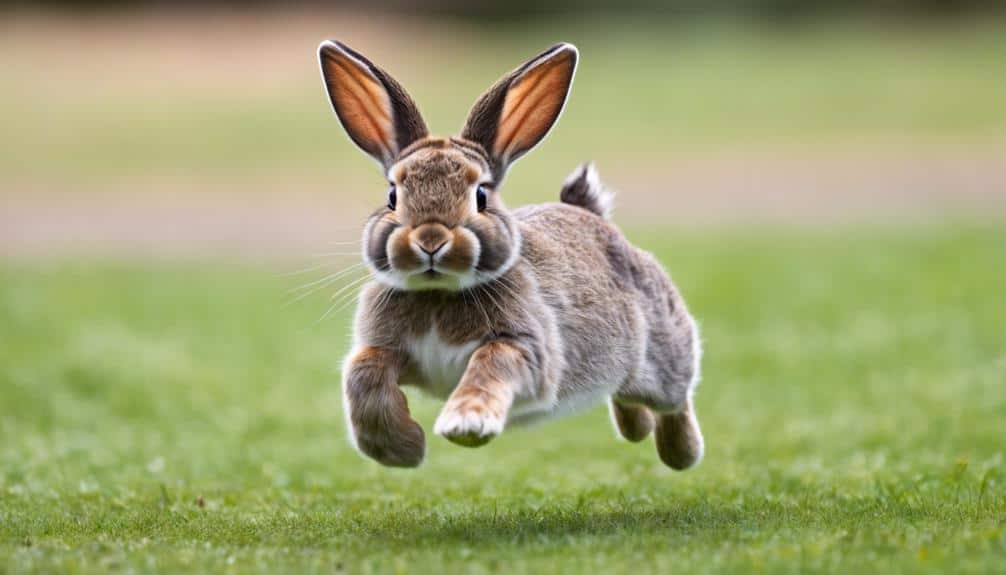
Rabbits are super speedy and agile when they jump. They can zip around at speeds between 25 and 45 mph, which helps them quickly escape from predators. Some types of rabbits, like European hares and jack rabbits, can even hit 45 mph, showing off their awesome hopping skills. Their strong back legs give them the power they need for these fast jumps. In fact, rabbits are faster than most house cats because they can go from 0 to zoom in no time.
Rabbits and hares, part of the Leporidae family, are all about that speed and agility. This combo lets them zip through their surroundings, dodge danger, and flaunt their athletic prowess.
Communication Through Bunny Hops
Rabbits talk to each other by hopping around in different ways. It's like they've their own hoppy language to share important messages with their bunny friends. Here are three ways rabbits use hopping to chat with each other:
- Escaping from Dangers: When rabbits feel scared or see something dangerous, they start hopping in a special way to warn their buddies. They might hop quickly in a zig-zag pattern or jump really high to show that there's a predator nearby. These hops tell other rabbits to run away and stay safe.
- Claiming Their Space: Hopping helps rabbits show who's boss in their territory. They use specific hops and thumps to mark their area and tell other rabbits to stay out. Different hoppy moves let them say, 'This is mine!' or 'Don't come in here!'
- Sharing Feelings: Rabbits also use hopping to express how they're feeling to their pals. Whether they're happy, excited, or just having fun, rabbits hop around to show it. Playful hops, energetic jumps, and binkies (twists and turns in the air) are ways rabbits tell each other, 'I'm feeling great!' and strengthen their friendships.
Social Dynamics of Bunny Hopping
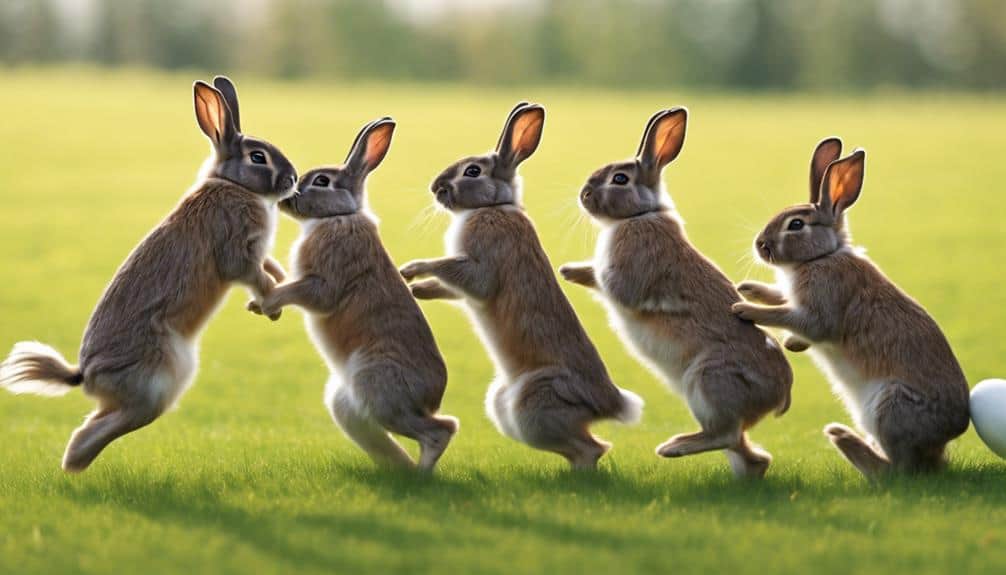
Bunnies have a pretty interesting way of communicating and organizing themselves when they hop around. It's like they've their own little language through hopping, showing who's in charge and how they all fit together in their group. The bunnies that lead the pack usually hop with more confidence and purpose, making it clear who's the boss and who's following along.
When bunnies hop around, they're also marking their territory. By using specific hopping patterns, they can show which areas belong to them and which ones are off-limits to others. It's like they're laying down invisible lines to avoid any misunderstandings or conflicts with neighboring bunny groups.
And when bunnies hop together in sync, especially during playtime, it's like they're strengthening their friendships and bonds. It's their way of saying, 'Hey, we're all in this together!' These coordinated hops help them feel connected and united as a bunny community.
Frequently Asked Questions
Do Rabbits Jump or Hop?
Rabbits hop more than they jump. Their bodies are built for hopping with strong hind legs that help them move quickly and efficiently. This hopping ability is important for their survival, helping them escape from predators, communicate with other rabbits, and show their emotions.
What Makes the Bunny Hop?
Ever wondered why bunnies hop around so effortlessly? It all comes down to their strong muscles, special way of moving, and how it helps them survive and thrive. Bunnies have back leg muscles that are even stronger than those of a cheetah, which allows them to be quick, agile, and make those impressive leaps.
Why Do Rabbits Hop Instead of Run?
Rabbits hop instead of run because it helps them move quickly and efficiently, especially when they need to escape from predators. Their bodies are built for hopping, making it a natural and instinctive way for them to get around different types of environments. It's like their superpower for staying safe and getting where they need to go in a hurry!
What Does It Mean When a Bunny Hops?
When a bunny hops, it means they are feeling happy, playful, and sociable. Hopping is how they show their energy and emotions. Watching a bunny hop can tell you a lot about how they are feeling and how they are interacting with others.
Conclusion
So basically, when bunnies hop, they use their strong back leg muscles, special skeleton features, and clever energy-saving tricks. These bunny-specific traits help them jump super fast and agile, while also letting them communicate and socialize with each other.
The hopping skills of bunnies really show off how cool and unique they're in the animal world.


